![]()
![]()
![]()
Use LEFT and RIGHT arrow keys to navigate between flashcards;
Use UP and DOWN arrow keys to flip the card;
H to show hint;
A reads text to speech;
49 Cards in this Set
- Front
- Back
|
Analog and digital signals ? |
Analog : is a continuous wave form that change smoothly over time Digital : is discrete. It can have only a limited number of defined values. Often as 1 or 0 |
|
|
Maximum count formula ? |
2^n-1 |
|
|
vcc and ground #s |
14 = vcc 7 = ground |
|
|
Basic Boolean algebraic identities Additive A+0=? A+1= A+A= A+ A(not) = Multiplicative 0xA= 1xA= AA= AA(not)= |
Additive 0 1 A 1 Multiplicative 0 A A 0 |
|
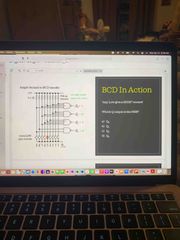
Front (Term) |
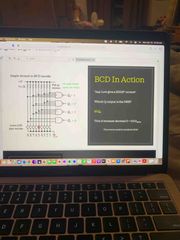
Back (Definition) |
|

Front (Term) |
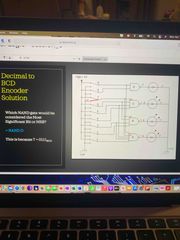
Back (Definition) |
|
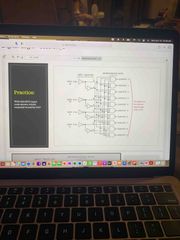
Front (Term) |
None, anything over 9 is invalid |
|
|
SR latch What gates does active low & active high have ? |
Active low=Nand gates Active high = Nor gates |
|
|
Active high Memory ? Reset? Set Invalid ? |
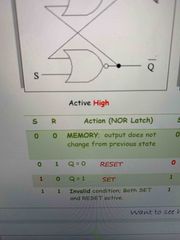
|
|
|
Active low Memory ? Reset? Set? Invalid |
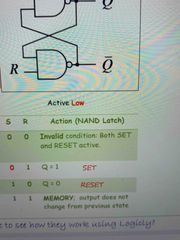
Back (Definition) |
|
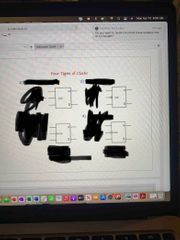
Front (Term) |
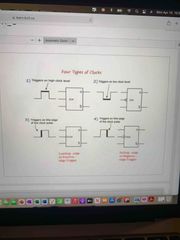
Back (Definition) |
|
|
D - flip flop What’s the most important thing to remember |
Q follows d - but only on the clock |
|
|
J K flip flop 1)J = 0 k=0 = ? 2) J=0 k=1 =? 3) J= 1 k= 0 = ? 4) J= 1 k= 1 =? |
1) memory 2) reset 3) set 4) toggle |
|
|
1) Asynchronous inputs are used for what? 2) The preset and clear input make Q change instantly cause why? |
1) used to override the clock / data inputs and force the outputs to a predefined state 2) they’re above the clock |
|
|
TTL ICS Power supply ? Logic Low ? Logic high? Undefined zone? And why? |
+5v 0-0.8v 2-5v 0.8-2v undefined - such voltages cause unpredictable results and problems for logic circuits |
|
|
Floating inputs in TLL & CMOS In TTL ? In CMOS ? |
In TTL. IC behaves if it had a input of 1 on the floating input In CMOS, IC doesn’t clearly see the floating input as being either a 1 or 0. A floating input to a cmos logic gate may create excessive temperature rise and cause the gates destruction |
|
|
For AND & NAND floating input is connected to ? For OR or NOR the unused inputs are connected to? |
AND & NAND = Vcc OR & NOR = ground |
|
|
If the input clock frequency to the a ripple up- counter was 1,000,000hz. What’s the frequency output? |
D) 1000000/ 16 = 62.5khz |
|
|
How would you create a MOD -6 |
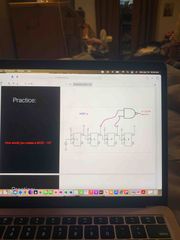
Back (Definition) |
|
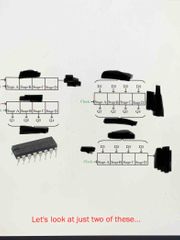
Front (Term) |
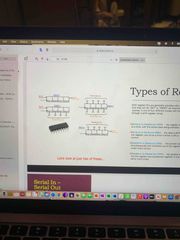
Back (Definition) |
|
|
Parallel-in parallel out (PIPO) shift register Advantages? |
Fast! With the single clock pulse, all bits are transferred |
|
|
Four main types of flip flops ? |
SR Data JK Clocked SR |
|
|
What makes a flip flop synchronous ? |
Clock input |
|
|
Clocked j-k flip flop in normally used in the what mode when j-k being both high? |
Toggle mode |
|
|
In the set mode, the Q output of the flip flop is logic level? |
1 |
|
|
Inputs preset & clear are called what |
Asynchronous. They don’t require a clock to function. They overide the clock |
|
|
What’s the functions of preset & clear inputs ? |
Preset to make Q=1 Set to make the Q=0 |
|
|
Flip - flops are wired together to form what kind of device ? |
Counter & shift registers |
|
|
Name one application of the simple SR flip - Flop |
Switch de-bouncer |
|
|
In the toggle mode, how is the output frequency of the Q output related to the clock pulse frequency in the J-K flip flop? |
Frequency of Q= frequency of clock + 2 |
|
|
CMOS ? CMOS can operate a supply voltage between ? Logic low percentage ? Logic high percentage ? |
Supply voltage = 3-18 Low :30% High :70 % |
|
|
CMOS if you were supplying a voltage of 15v What would be the logic high and low for that supply. What’s it’s undefined region? |
Logic low = 0-4.5 v Logic high = 10.5-15v Undefined region = 4.5v-10.5v |
|
|
Floating input? |
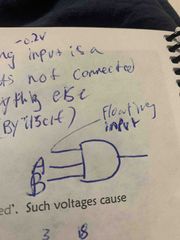
It’s a input that’s not connected to anything else |
|
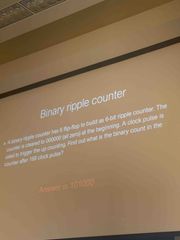
Front (Term) |
In Calculator 168 to binary = 10101000 Since it says 6 flip-flops, you keep six of the last binaries. = 101000 |
|
|
Shift register used ? |
Used for data storage or for the movement of data |
|
|
Synchronous counters have their clocks inputs connected in |
Parallel |
|
|
What’s the purpose behind adding gates to flip flops used in binary ripple counters ? |
Stopping a count…. Forcing it to recycle |
|
|
What’s the largest binary number a modulus -16 will count to |
1111 which is 15 |
|
|
Two disadvantages of serial in / serial out ? |
2) In order to transfer a nibble of data (4-bits) FOUR shift pulses are required ( slow) 2) After each shift pulse the data stored in the last register is lost as it’s shifted out |
|
|
Parallel in / parallel out register may be used to store ? |
Binary data |
|
|
PIPO 1) data is normally transferred within a computer in parallel to allow ? 2) data is stored in parallel format because this allows high-speed read operations to? |
1) allow high-speed data transfer 2) be performed by the computer |
|
|
True or false ? SI/SO registers destroy the data bits as they are shifted out of the register |
True |
|
|
1) Shift register is made up by primarily of ? 2) an 8-but shift register has a storage capacity of ? 3) for an 8-bit serial input register, the number of data bits that can be entered on each clock pulse is ? |
1) flip-flops 2) 1 byte 3) eight |
|
|
1) Shift register is made up by primarily of ? 2) an 8-but shift register has a storage capacity of ? 3) for an 8-bit serial input register, the number of data bits that can be entered on each clock pulse is ? |
1) flip-flops 2) 1 byte 3) eight |
|
|
1) For a parallel input shift register, the number of data bits that can be entered on each clock pulse? 2) to serially shift byte of data into a 8 bit shift register, there must be ? |
1) depends on the number of flip flops 2) eight clock pulses? |
|
|
1) A register is a group of latches or flip-flops used to transfer, store or shift data. True or false ? 2) what type of register would be used to take parallel data from within a digital system and convert it to a format for transmission over a single line ? |
1) true 2) parallel in / parallel out |
|
|
Data transformed out a parallel in / parallel out register are normally destroyed ? |
False |
|
|
Nanoseconds for TTL & CMOS |
TTL= 5-10 nanonseconds Cmos = 30-40 nanoseconds |
|
|
What type of flip flop do shift registers use |
D- type flip flops |

